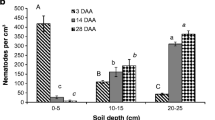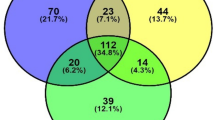Abstract
The potential for transfer of the protozoan pathogen Cryptosporidium parvum through soil to land drains and, subsequently, water courses following the application of livestock waste to land was monitored in the laboratory using simulated rainfall and intact soil cores. Following irrigation over a 21-day period, Cryptosporidium parvum oocysts applied to the surface of soil cores (initial inoculum concentration 1×108 oocysts core−1) were detected, albeit in low numbers, in the leachates from clay loam and silty loam soils but not in that from a loamy sand soil. Variations in leaching patterns were recorded between replicate cores. At the end of the study soil cores were destructively sampled to establish the location of oocysts remaining within the soil. Distribution within cores was similar in all three soil types. The majority (72.8+-5.2%) of oocysts were found in the top 2 cm of soil, with numbers decreasing with increasing depth to 13.2±2.8%, 8.39±1.4%, and 5.36±1.4% at depths of 10, 20, and 30 cm, respectively.
Similar content being viewed by others
References
Bashan Y, Levanony H (1988) Adsorption of the rhizosphere bacterium Azospirillum brasilense Cd to soil, sand and peat particles. J Gen Microbiol 134:1811–1820
Bentjen SA, Fredrickson JK, van Voris P, Li SW (1989) Intact soil core microcosms for evaluating the fate and ecological impact of the release of genetically engineered microorganisms. Appl Environ Microbiol 55:198–202
Bitton G, Harvey RW (1992) Transport of pathogens through soils and aquifers. In: Mitchell R (ed) Environmental microbiology. Wiley-Liss, New York, pp 103–124
Bitton G, Lahav N, Henis Y (1974) Movement and retention of Klebsiella aerogenes in soil columns. Plant and Soil 40:373–380
Burge WD, Enkiri NK (1978) Virus adsorption by five soils. J Environ Qual 7:73–76
Campbell AT, Robertson LJ, Smith HV (1992) Viability of Cryptosporidium parvum oocysts: Correlation of in vitro excystation with inclusion or exclusion of fluorogenic vital dyes. Appl Environ Microbiol 58:3488–3493
Casemore DP, Armstrong M, Sands RL (1985) Laboratory diagnosis of cryptosporidiosis. J Clin Pathol 38:1337–1341
Current WL (1987) Cryptosporidium: Its biology and potential for environmental transmission. CRC Crit Rev Environ Control 17:21–51
Elliott LF, Ellis JR (1977) Bacterial and viral pathogens associated with land application of organic wastes. J Environ Qual 6:245–251
van Elsas JD, Trevors JT, van Overbeek LS (1991) Influence of soil properties on the vertical movement of genetically marked Pseudomonas fluorescens through large soil microcosms. Biol Fertil Soils 10:249–255
Fayer R, Speer CA, Dubey JP (1990) General biology of Cryptosporidium. In: Dubey JP, Speer CA, Fayer R (eds) Cryptosporidiosis of man and animals. Chemical Rubber Company Press, Boca Raton, Fla, pp 1–29
Gannon JT, Manilal VB, Alexander M (1991a) Relationship between cell surface properties and transport of bacteria through soil. Appl Environ Microbiol 57:190–193
Gannon JT, Mingelgrin U, Alexander M, Wagenet RJ (1991b) Bacterial transport through homogenous soil. Soil Biol Biochem 23:1155–1160
Gerba CP, Wallis C, Melnick JL (1975) Fate of wastewater bacteria and viruses in soil. J Irrig Drain Div Am Soc Civ Eng 101:157–174
Griffin DM, Quail G (1968) Movement of bacteria in moist, particulate systems. Aust J Biol Sci 21:579–582
Grimason AM, Smith HV, Smith PG, Jackson ME, Girdwood RWA (1990) Waterborne cryptosporidiosis and environmental health. Environ Health 1990:228–233
Guy EM, Visser TA (1979) Adsorption and survival patterns of Escherichia coli and Streptococcus bovis in six New Zealand soils. NZ J Agric Res 22:341–348
Huysman F, Verstraete W (1993) Water facilitated transport of bacteria in unsaturated soil columns: Influence of cell surface hydrophobicity and soil properties. Soil Biol Biochem 25:83–90
Kandeler E, Eder G (1993) Effect of cattle slurry in grassland on microbial biomass and on activities of various enzymes. Biol Fertil Soils 16:249–254
Kearney TE, Larkin MJ, Levett PN (1993) The effect of slurry storage and anaerobic digestion on survival of pathogenic bacteria. J App Bacteriol 74:86–93
Khaleel R, Reddy R, Overcash MR (1980) Transport of potential pollutants in runoff water from land areas receiving animal waste: a review. Water Res 14:421–436
Kuikman PJ, van Elsas JD, Jansen AG, Burgers SLGE, van Veen JA (1990) Population dynamics and activity of bacteria and protozoa in relation to their spatial distribution in soil. Soil Biol Biochem 22:1063–1073
Marshall KC (1971) Sorptive interactions between soil particles and microorganisms. Soil Biochem 2:409–445
Mawdsley JL (1994) Movement and viability of the protozoan pathogen Cryptosporidium in three contrasting soil types. In: Pankhurst CE (ed) Soil biota — management in sustainable farming systems. CSIRO Press, Melbourne, pp 87–89
Paterson E, Kemp JS, Gammack SM, Fitzpatrick EA, Cresser MS, Mullins CE, Killham K (1993) Leaching of genetically modified Pseudomonas fluorescens through intact soil microcosms: Influence of soil type. Biol Fertil Soils 15:308–314
Postma J, Walter S, van Veen JA (1989) Influence of different initial soil water contents on the distribution and population dynamics of introduced Rhizobium leguminosarum biovar trifolii. Soil Biol Biochem 21:437–442
Reddy KR, Khaleel R, Overcash MR (1981) Behaviour and transport of microbial pathogens and indicator organisms where soils are treated with organic wastes. J Environ Qual 10: 255–266
Robertson LJ, Smith HV (1992) Cryptosporidium and Cryptosporidiosis. Current perspective and present technologies. Eur Microbiol 1:20–29
Skibber U, Cresser MS (1986) Effects of precipitation acidity on the chemistry and microbiology of sitka spruce litter leachate. Environ Pollut 42:65–78
Smith HV (1992) Cryptosporidium and water: a review. J Inst Water Environ Manage 1992:443–451
Smith MS, Thomas GW, White RE, Ritonga D (1985) Transport of Escherichia coli through intact and distubed soil columns. J Environ Qual 14:87–91
Sterling CR (1990) Waterborne cryptosporidiosis. In: Dubey JP, Speer CA, Fayer R (eds) Cryptosporidiosis of man and animals. Chemical Rubber Company Press, Boca Raton, Fla, pp 51–58
Strauch D (1987) Hygiene of animal waste management. In: Strauch D (ed) Animal production and environmental health — world animal science. Elsevier, Amsterdam, pp 155–202
Tan Y, Bond WJ, Rovira AD, Brisbane PG, Griffin DM (1991) Movement through soil of the biological control agent Pseudomonas fluorescens. Soil Biol Biochem 23:821–825
Tan Y, Bond WJ, Griffin DM (1992) Transport of bacteria during unsteady unsaturated soil water flow. Soil Sci Soc Am J 56: 1331–1340
Thomas GW, Phillips RE (1979) Consequences of water movement in macropores. J Environ Qual 8:149–152
Trevors JT, van Elsas JD, van Overbeek LS, Starodub ME (1990) Transport of genetically engineered Pseudomonas fluorescens strain through a soil microcosm. Appl Environ Microbiol 56:401–408
Ungar BLP (1990) Cryptosporidiosis in humans (Homo sapiens). In: Dubey JP, Speer CA, Fayer R (eds) Cryptosporidiosis of man and animals. Chemical Rubber Company Press, Boca Raton, Florida, pp 59–82
West PA (1991) Human pathogenic viruses and parasites: Emerging pathogens in the water cycle. J Appl Bacteriol Suppl 70: 107S-114S
White RE (1985) The influence of macropores on the transport of dissolved and suspended matter through soil. Adv Soil Sci 3:95–120
Wollum AG, Cassel DK (1978) Transport of microorganisms in sand columns. Soil Sci Soc Am J 42:72–76
Author information
Authors and Affiliations
Rights and permissions
About this article
Cite this article
Mawdsley, J.L., Brooks, A.E. & Merry, R.J. Movement of the protozoan pathogen Cryptosporidium parvum through three contrasting soil types. Biol Fertil Soils 21, 30–36 (1996). https://doi.org/10.1007/BF00335990
Received:
Issue Date:
DOI: https://doi.org/10.1007/BF00335990




